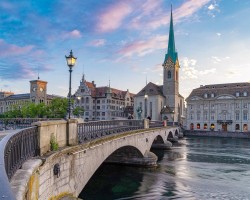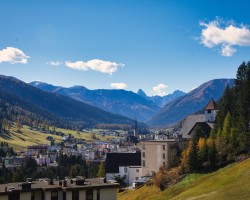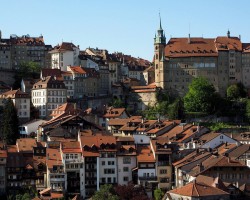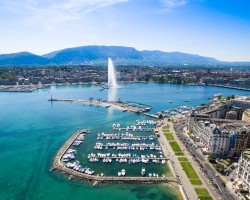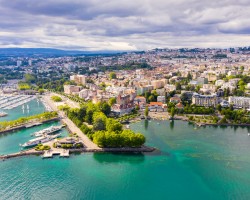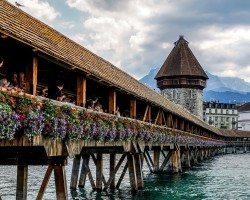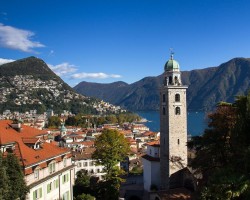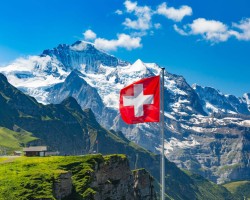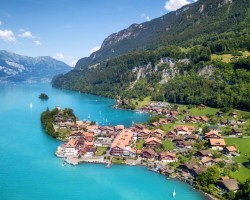Best time to go to Switzerland for a perfect weather and where to go?
When is the best time to go to Switzerland?
To have the most pleasant weather, the best time to visit Switzerland is between July and September. Indeed, these are the driest months of the year and when the temperatures are the mildest.
However, it is entirely possible to visit Switzerland in any season. It all depends on the experiences you wish to have there.
Switzerland in Spring
- If you want to take a city trip, April is a feasible month in the northern cities of the country, such as Basel or Zurich. Elsewhere, like in Bern, Geneva, Lausanne, Fribourg, or Montreux, it is better to wait until May or June for good weather conditions.
- For hiking, favor the northern part of Switzerland starting in May. With temperatures around 20°C (68°F) and dry weather, all the ingredients are in place for unforgettable days.
- It is still possible to ski in Eastern Switzerland until the end of April, or even early May depending on the year.
In summary, spring is a good season to go to Switzerland, provided you choose the most favorable regions. You can then mix nature escapes and cultural stays in the most beautiful cities of the country, all with low tourist traffic.
Switzerland in Summer
Between the end of June and the end of September, the high season is in full swing in Switzerland. The weather is beautiful throughout the territory, although scattered rain may occur, especially in the southern half of the country. Unsurprisingly, it is in Ticino, particularly around Lugano near the Italian border, that it is the hottest, while it is cooler in the eastern Alps. However, temperatures are pleasant everywhere and conducive to many outdoor activities. For example, you can:
- Take a road trip to discover the most beautiful villages in Switzerland, such as Sion, Morcote, or Grindelwald.
- Go hiking on foot or by bike for a day or for a longer trek.
- Engage in water sports on lakes or rivers, such as rafting, canoeing, stand-up paddleboarding, kayaking, or even sailing.
- Cool off by visiting glaciers in the Valais or Graubünden Alps, where they are still plentiful.
Switzerland in Autumn
When considering when to visit Switzerland, autumn is not an obvious choice. However, temperatures remain comfortable until the end of October in the central and northern parts. Moreover, nature displays sensational colors!
Despite uncertain weather, it is therefore a good time for walking and sightseeing. Starting in November, the weather becomes less favorable, with temperatures dropping drastically. But the first snows arrive in the Alps, and you can already enjoy the joys of winter sports.
Switzerland in Winter
For lovers of sliding sports and mountain holidays, winter is of course a prime season to visit Switzerland. Despite very high prices, ski resorts are packed until March, and snow is abundant in the mountains.
At lower altitudes, temperatures range from 0 to 5°C (41°F) until the end of February, and March offers milder averages. If the mountains are not your thing and you prefer urban settings, then this is not the best time to go to Switzerland. Unless you want to experience the magic of Christmas in the main cities of the country.
Where and when to go based on the weather?
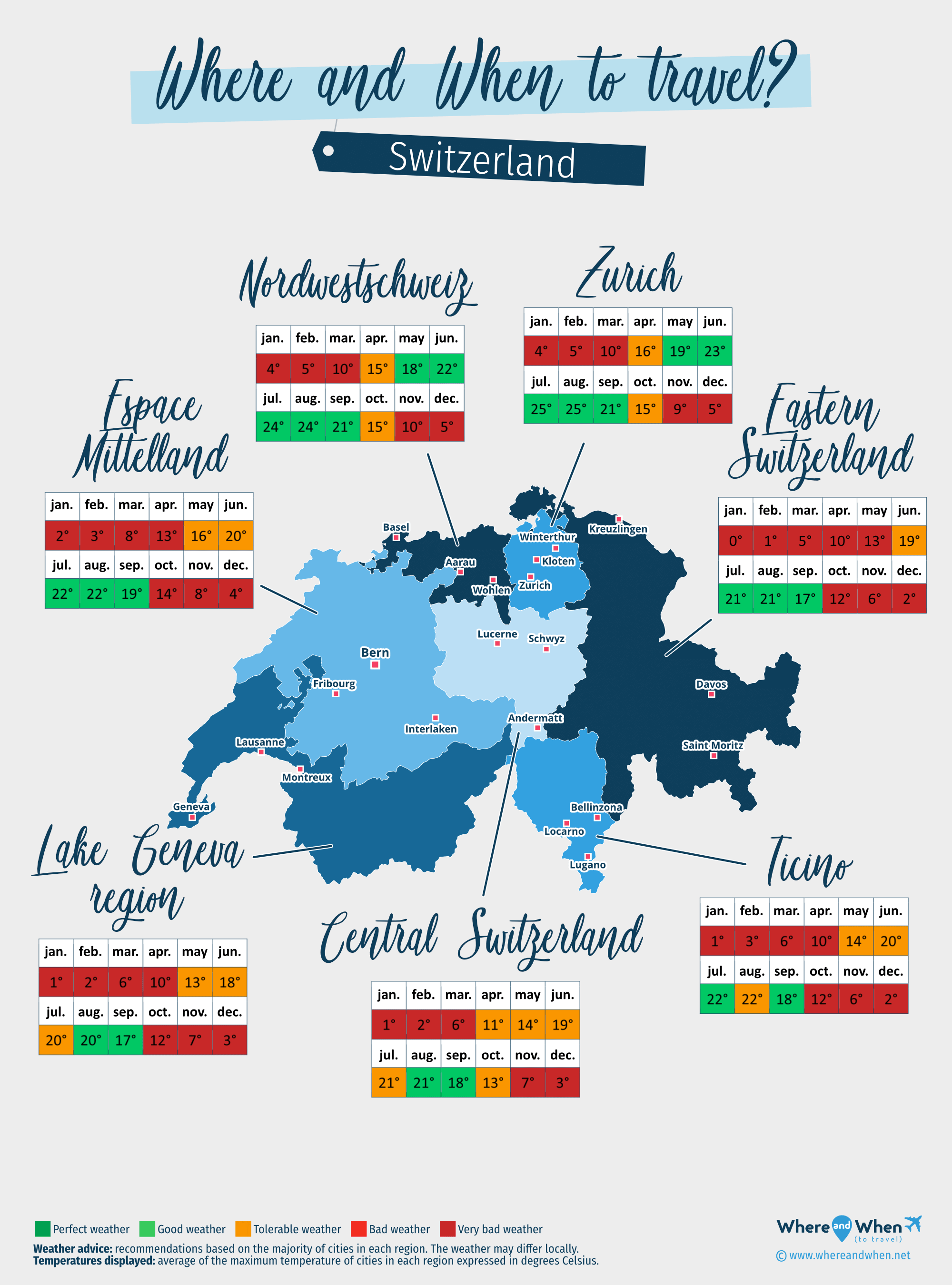
Central Switzerland
Lucerne, Schwyz, Andermatt...
Eastern Switzerland
Davos, Kreuzlingen, Saint Moritz...
Espace Mittelland
Fribourg, Bern, Interlaken...
Lake Geneva region of Switzerland
Geneva, Lausanne, Montreux...
Nordwestschweiz
Basel, Aarau, Wohlen...
Ticino
Lugano, Locarno, Bellinzona...
Zurich
Zurich, Winterthur, Kloten...
To get all the information about the climate and weather in Switzerland for a specific month, click on the corresponding link below:
Switzerland in january Switzerland in february Switzerland in march Switzerland in april Switzerland in may Switzerland in june Switzerland in july Switzerland in august Switzerland in september Switzerland in october Switzerland in november Switzerland in december
Best time to travel to Switzerland by cities
Climate and Weather in Switzerland
The country being located between Italy, Austria, France, and Germany, the climate of Switzerland is diverse from one region to another, despite the small size of its territory:
- The temperate oceanic climate is largely predominant, as it is present in 68% of the territory. This is the climate found notably around Zurich, Lucerne, Geneva, and in almost the entirety of the Mittelland area, in western Switzerland.
- A tundra polar climate prevails in almost all of the Swiss Alps, from Davos to Gstaad, passing through Zermatt.
- A cold winter subarctic climate is mainly present in Ticino, at the Italian border, as well as in the Sarnen region in the canton of Obwald, right in the center of the country.

Climate in Ticino, the Lake Geneva region, and the center
In Ticino as well as in the Lake Geneva region, winters are long and rainy. The weather is unfavorable from October to April with temperatures ranging between 1 and 7°C (45°F) from November to March and between 10 and 12°C (54°F) in October and April. Throughout this period, it rains regularly and the sky often remains gray. At the same time, the weather in central Switzerland is similar, but the months of April and October are a bit warmer and drier.
May and June are particularly rainy in these regions. The atmosphere is therefore humid and temperatures struggle to rise. The average temperature is 14°C (58°F) in May and between 18 and 20°C (68°F) as summer approaches.
Even though the thermometer rises significantly in July, the Lake Geneva region and the center are still under rain. It is therefore better to favor Ticino during this time.
In August and September, temperatures range between 17 and 22°C (72°F) , but it is not uncommon for the thermometer to rise above 25°C (77°F) in the middle of the day. While Ticino experiences another rainy period in August, the other regions enjoy a clear blue sky.
Climate in the Mittelland area
In this region of Switzerland, the weather is characterized by milder temperatures and less precipitation than in areas located further south or in the center.
- In winter, from December to February, the average temperature is 2 to 4°C (40°F) during the day, but the minimum temperatures are generally negative at night.
- The interseasons experience a humid and fairly cool climate. It is around 8°C (47°F) in March as well as in November, while the thermometer fluctuates between 13 and 14°C (58°F) in April and October.
- May and June are the rainiest months of the year, even though it is mild, between 16 and 20°C (68°F) .
- In summer, the climate is very favorable. Expect around 24°C (76°F) in July-August and 21°C (70°F) in September. This last month is indeed drier than the others.
Climate in the canton of Zurich and the northwest
These two regions located in the north of the country have the mildest and most pleasant climate. Thus, the best time to visit is between May and September.
- In the interseasons, in May, June, and September, the sun shines and temperatures range between 18 and 23°C (74°F) . In spring, it rains regularly, but this should not spoil your stay.
- In July and August, expect maximum temperatures around 25°C (77°F) . Even though thunderstorms may occur, the weather is generally quite dry.
- April and October are two transitional months. The air is cool, around 15°C (59°F) , and quite humid.
- In winter, from November to March, temperatures range between 4 and 10°C (50°F) , with the months of December to February being the coldest of the year. Showers are regular but relatively light, and the sky is often overcast, enhancing the feeling of coolness.
Climate in Eastern Switzerland
It is in this region of the eastern part of the country that the climate is the harshest, especially during the winter season. From November to March, the averages range between 0 and 6°C (43°F) , but nighttime temperatures often hover around -5°C, especially in January.
In spring and autumn, the thermometer struggles to exceed 10°C (50°F) , but a warm and dry wind, the Foehn, can blow, softening the atmosphere.
In summer, the climate is favorable, although rainy. It is around 25°C (77°F) in July and August and 21°C (70°F) in September.
Temperatures and rainfall in Switzerland
On these 2 graphs, we present the evolution of temperatures of Switzerland and month-by-month rainfall for the cities of Zurich, Basel, Bern, Davos and Fribourg.
Peak visitor numbers and tourist seasons in Switzerland
Find out when Switzerland has its high tourist season (the period when the influx of tourists is highest) and off-peak tourist season using our data and figures.
Tourist seasons in Switzerland
The months with low numbers of tourists are: January, February, March, April, May, November and December. The number of visitors to Switzerland is high in: June, July, August, September and October.
- Very low season in Switzerland: January, February, March, April and November.
- Low season in Switzerland: May and December.
- High season in Switzerland: June, September and October.
- Peak season in Switzerland: July and August.
Figure: Visitor index for Switzerland month by month
Average price for flights to Switzerland
A return flight between New York City and Zurich is generally cheaper if you go in november ($ 767 on average): this is the best time for travellers on a tight budget. In contrast, you may end up paying $ 565 more for your airline ticket to Zurich if you go in june.
Find the best price for your flight Flight prices to Switzerland
Where to go in Switzerland?
This table allows you to see the maximum temperature for each city and our opinion on the weather month by month (see colour legend below the table).
| Cities | jan. | feb. | mar. | apr. | may | jun. | jul. | aug. | sep. | oct. | nov. | dec. |
| Zurich | 40°F | 43°F | 52°F | 61°F | 67°F | 76°F | 79°F | 77°F | 70°F | 61°F | 50°F | 41°F |
| Basel | 41°F | 45°F | 52°F | 61°F | 67°F | 74°F | 77°F | 77°F | 72°F | 61°F | 52°F | 43°F |
| Bern | 40°F | 41°F | 50°F | 59°F | 65°F | 72°F | 76°F | 76°F | 70°F | 61°F | 50°F | 41°F |
| Davos | 27°F | 29°F | 34°F | 41°F | 49°F | 59°F | 63°F | 63°F | 56°F | 47°F | 38°F | 31°F |
| Fribourg | 40°F | 41°F | 49°F | 59°F | 63°F | 72°F | 76°F | 76°F | 68°F | 61°F | 50°F | 43°F |
| Geneva | 40°F | 43°F | 50°F | 59°F | 65°F | 74°F | 77°F | 77°F | 70°F | 63°F | 52°F | 43°F |
| Lausanne | 40°F | 41°F | 49°F | 58°F | 63°F | 70°F | 74°F | 74°F | 68°F | 59°F | 50°F | 43°F |
| Lucerne | 41°F | 43°F | 50°F | 59°F | 65°F | 72°F | 76°F | 77°F | 70°F | 61°F | 52°F | 43°F |
| Lugano | 45°F | 47°F | 54°F | 63°F | 68°F | 77°F | 83°F | 81°F | 74°F | 63°F | 54°F | 45°F |
| Aarau | 40°F | 41°F | 50°F | 59°F | 65°F | 74°F | 76°F | 76°F | 70°F | 59°F | 50°F | 43°F |
| Andermatt | 29°F | 31°F | 36°F | 41°F | 50°F | 61°F | 65°F | 65°F | 58°F | 49°F | 40°F | 31°F |
| Bellinzona | 36°F | 38°F | 45°F | 52°F | 59°F | 68°F | 74°F | 72°F | 65°F | 56°F | 45°F | 38°F |
| Interlaken | 31°F | 31°F | 36°F | 43°F | 49°F | 59°F | 63°F | 65°F | 58°F | 49°F | 40°F | 32°F |
| Kloten | 40°F | 43°F | 52°F | 61°F | 67°F | 76°F | 79°F | 77°F | 70°F | 61°F | 50°F | 41°F |
| Kreuzlingen | 40°F | 41°F | 50°F | 61°F | 65°F | 74°F | 77°F | 77°F | 70°F | 61°F | 50°F | 43°F |
| Locarno | 34°F | 38°F | 45°F | 52°F | 59°F | 68°F | 74°F | 72°F | 67°F | 54°F | 43°F | 36°F |
| Montreux | 34°F | 36°F | 41°F | 50°F | 56°F | 65°F | 68°F | 70°F | 63°F | 56°F | 45°F | 38°F |
| Morges | 40°F | 41°F | 49°F | 58°F | 63°F | 70°F | 74°F | 74°F | 68°F | 59°F | 50°F | 43°F |
| Morgins | 34°F | 34°F | 41°F | 50°F | 56°F | 63°F | 68°F | 68°F | 61°F | 54°F | 43°F | 36°F |
| Saint Moritz | 25°F | 29°F | 32°F | 38°F | 45°F | 58°F | 63°F | 63°F | 56°F | 45°F | 36°F | 27°F |
Legend:
good weather
tolerable weather
very bad weather
About Switzerland
What can I do in Switzerland?
Beaches / swimming
Nature and countryside
Culture and heritage
Sports
Family travel
Crafts / shopping
Gastronomy
Nightlife
Is this weather information for Switzerland reliable?
Climate data for Switzerland has been gathered every day since January 2009. The analysis of these meteorological data for Switzerland allows us to determine the average for each month in Zurich, Basel, Bern, Davos, Fribourg, Geneva, Lausanne, Lucerne, and 72 other cities.
So yes: this data is reliable except in cases of temporary climate disruption in the region.

